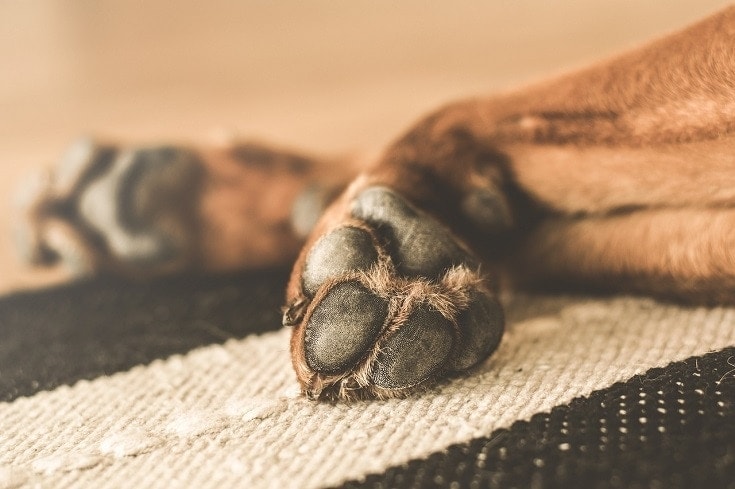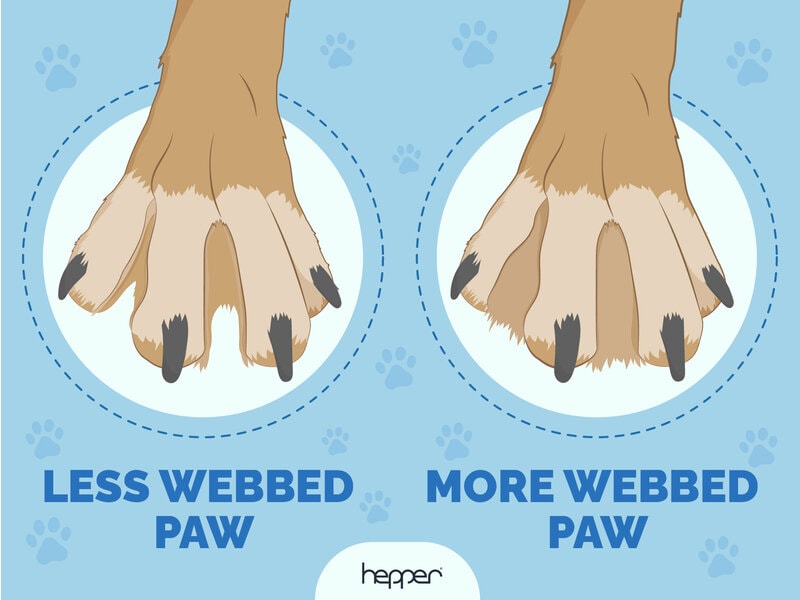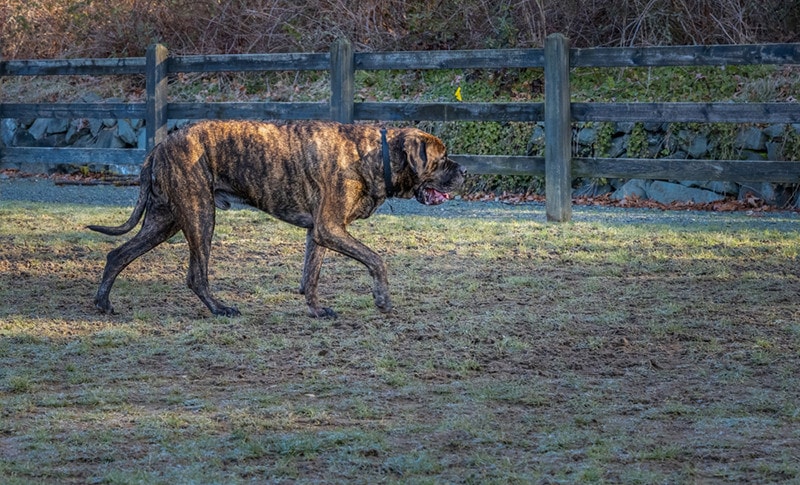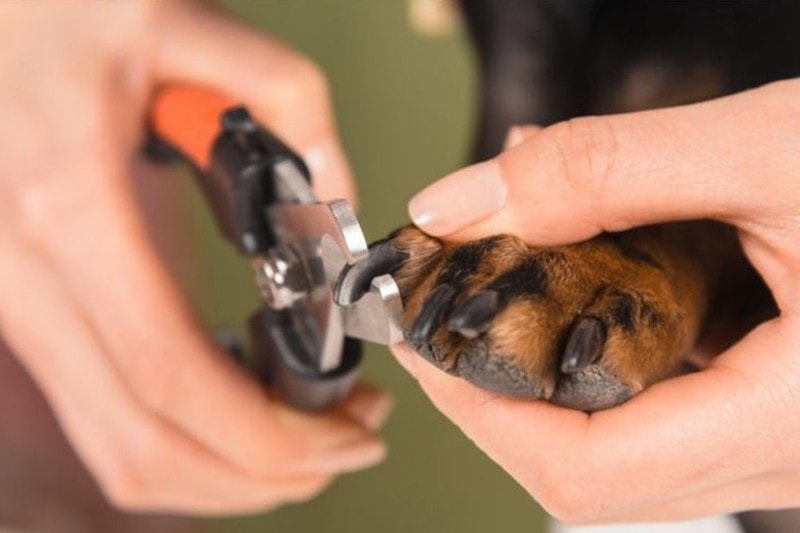Do Mastiffs Have Webbed Feet? The Interesting Answer
Updated on

Mastiffs are famous for their immense size, slobbery jowls, and stoic yet gentle dispositions. But what they aren’t necessarily known for is swimming. So, do they have webbed feet, like many other dogs?
Most Mastiffs do not have webbed feet, but some might have a small amount of webbing.
If you’re interested in learning more about webbed feet and why the Mastiff doesn’t have them, read on!
What Are Webbed Feet?
It’s likely that the first things you think about when you hear webbed feet are frogs, geese, and ducks. Since dogs have paws that you don’t typically see spread apart, you would never guess that some of them also have webbing.
The webbing is a piece of skin or membrane that stretches out between the toes when they’re spread. Most animals and birds that live in or near water or do a great deal of digging have webbing, including beavers, turtles, and moles.
Webbed feet are effective at propelling the animal or bird through the water and scooping soil out of the way for burrowing.
A bird stretches their toes and webbing apart as they push their foot backward, and when they pull the foot forward, they fold the toes together to lessen the resistance. In this way, they can paddle quite effectively across the water.
Why Do Some Dogs Have Webbed Feet?

Webbing not only helps with swimming and digging, but it can also help animals keep their balance over muddy and rough terrain. All dogs have some degree of webbing, but it typically comes down to what they were initially bred for.
The most common use for webbed feet is swimming, so breeds used for hunting and retrieving waterfowl or assisting with search and rescue usually have more noticeable webbing.
What Were Mastiffs Bred For?
The Mastiff is an ancient breed that is also known as the English Mastiff or Old English Mastiff. They go as far back as 55 B.C., when the Romans, led by Julius Caesar, invaded Britain. He noted these enormous dogs that helped defend their people, and he brought a few of them back to Rome.
Mastiffs were used as war dogs, guardians of British estates, and big-game hunters. They fought on the side of the British in the Battle of Agincourt and were even used in World War II, but only about 14 Mastiffs survived after the war.
Breeders from the U.S. brought them back from the brink of extinction, and today, they spend more time hanging out with their families rather than hunting big game.
Overall, the Mastiff was never meant to work around water, so these dogs aren’t the greatest swimmers. But they make excellent guardians and protectors, and webbed feet aren’t necessary for these jobs.
Are Mastiffs Able to Swim?

Mastiffs are not natural swimmers because they were not bred for this activity. They were guard and war dogs and their main duties occurred on land. They are also large and heavy, making it more difficult for them to swim.
Some Mastiffs will enjoy a good frolic in the water, while others will be terrified of it. Many Mastiffs need to be taught how to swim well.
If you decide to teach your Mastiff to swim, invest in a life jacket for dogs. It has a handle that can help you grab them if they get into trouble—though that might be a challenge, given how heavy this breed is!
What Breeds Have Webbing?
Dogs bred for swimming and dogs bred for digging—such as the Dachshund, which was bred to dig out badgers—have webbing because it allows for more effective digging.
Since most dogs have some kind of webbing, this list is not exhaustive.
- Labrador Retrievers: One of the world’s most popular dogs, the Lab is a retriever bred for swimming. They have webbed feet and water-repellent double coats.
- Poodles: The name Poodle is derived from the German word, Pudelhund, which means “puddle dog.” These dogs were also bred to be retrievers of waterfowl.
- Newfoundland: This Canadian breed has an immensely thick water-repellent coat and webbed feet that were used to help fishermen.
- Portuguese Water Dog: With the word “water” in the name, these dogs, like the Newfoundland, assisted fishermen with herding fish into their nets.
- Nova Scotia Duck Tolling Retriever: This is the third Canadian dog on this list, and it’s no coincidence that all three dogs come from the Maritimes! Tollers worked to entice prey for hunters by frolicking in the water.
- Chesapeake Bay Retriever: If they have “retriever” in the name, they likely worked near the water. Their primary job was hunting ducks along the Chesapeake Bay.
- German Short-Haired Pointer: These all-around hunting dogs traveled across all terrain—fields, forests, and near water.
- Irish Water Spaniel: This dog has water in their name, so it’s only natural that they have webbed feet. These dogs have been around since the 7th century as hunting dogs and retrievers.
- Otterhound: These dogs were used in medieval England for hunting otters, which is outlawed these days.
How to Take Care of Your Mastiff’s Feet
Whether your Mastiff has webbing or not, like all dogs, they need to have their feet looked after.
Check the Paws
Whenever you take your dog out for a walk, double-check their paws when you get home. This way, you can detect any injuries or if there’s something embedded in their pads. You should also be sure to check if your dog spends more time biting and licking their paws than usual.
In the winter, wipe off their paws when you arrive home, as you’ll want to remove any salt, dirt, and ice. Also, ensure that you check between the pads and toes.

Trim the Nails
Your dog’s nails should be trimmed at least once a month, but some dogs might need more frequent trims. You can get this done by a groomer if you find it too much of a challenge, but if you want to do it yourself but aren’t sure how, speak to your vet. They can show you the best way to trim your Mastiff’s nails.
Moisturize the Pads
You can use vitamin E or get pad balm or cream that you can rub into your dog’s pads. This will help keep them moisturized and protect them from cracking or chapping.
It can also protect a dog’s paws against snow and ice, as well as hot sidewalks, by providing a barrier against the elements.
Conclusion
Webbed feet can make swimming easier for any animal. All dogs have some webbing on their paws, but some breeds have more than others, particularly those bred for digging and working around water.
But even breeds that weren’t bred for swimming, digging, or hunting over challenging terrain might also have pronounced webbing. Mastiffs don’t tend to have noticeable webbing between their toes, but some individual dogs might.
While some Mastiffs might not be comfortable around water, you can teach them how to swim. But even if your Mastiff never really takes to the water, they still make incredibly wonderful companions!
Featured Photo Credit: LUM3N, Pixabay











